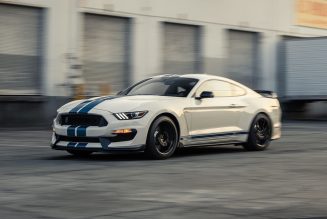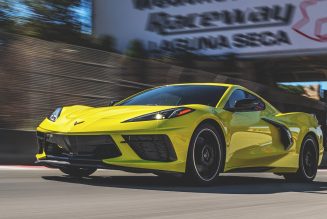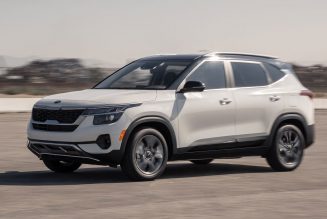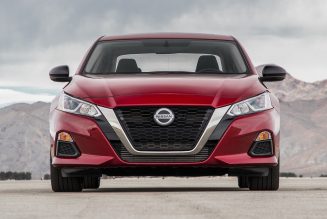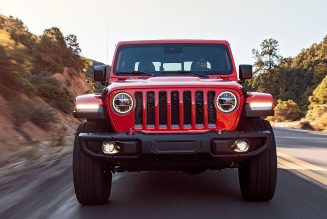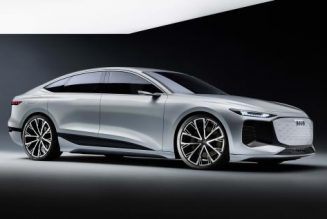With the recent reveal of the 2021 Mercedes-AMG GT Black Series, we thought now would be a great time to revisit the AMG GT’s legendary predecessor. From our April 1957 issue, here’s our First Test of the legendary Mercedes-Benz 300 SLR.
Every time Daimler-Benz returns to racing, success is achieved by a single-minded concentration of effort and resources, giving the appearance of inevitability. The cars, which open up new perspectives in design for high performance, are retired to places in the Daimler-Benz museum at Untertürkheim, and it is a rare occasion when the opportunity arises to study a design in detail. In the case of the famous World Championship Mercedes-Benz 300 SLR, the veil has been lifted.
In the spring of 1956, a few of us sat in the sun outside the elegant Schloss Solitude in the hills above Stuttgart, West Germany. Occasionally, the silence was shattered as a long, low silver projectile hurtled toward us at 100 miles per hour and then stopped a few yards away as though restrained by some supernatural force. No ordinary brakes could ever stop a car like that. The gullwing doors would open up; a passenger, dazed with noise, speed, and acceleration such as he had never before experienced, would climb out over the high side; another would step in, and Rudolf Uhlenhaut, director of the Daimler-Benz Experimental Department, would drive off, smiling happily, on another demonstration run.


Watching him go, and listening to the exhaust note as he changed gears up and down in the distance, Arthur Keser (the Daimler-Benz press chief) exclaimed, “Did you ever see anyone so happy at his work? He’s a toy maker, delighted to find people interested in his latest creation.”
And this was truly the most fabulous toy of all, the fastest car on the road anywhere in the world today. No one can possibly say how much it cost, and it is definitely not for sale. It is the Mercedes-Benz 300 SLR, the factory-raced sports car that won the World Championship for Constructors in 1955, with victories in the Mille Miglia, Targa Florio, and Tourist Trophy. It now has a coupe body instead of the open two-seater roadster body and is used by Uhlenhaut for fast long-distance motoring.
Not only is he responsible for development of Mercedes racing and sports cars; he also test-drives the racing cars, at speeds equal to those of top professional drivers, to learn the essential facts about car behavior that the professional driver so often can’t express. Besides, as he says, “At 50, you need to keep in practice.”
To ride in the 300 SLR with Uhlenhaut was a revelation: an object lesson in performance and how to use it. He seemed to be doing 100 miles per hour wherever there were a few hundred yards of clear road, but he never took a chance and always seemed to be driving with almost exaggerated respect for other traffic. But how to express such performance in terms which permit comparison with the ordinary cars we know today?
Daimler-Benz engineers had evaluated the racing performance in terms of power and torque, revolutions per minute and gear ratios, and lap times on given circuits, but had never done an ordinary road test. That started something, and a few weeks later (by courtesy of the Daimler-Benz management) I was able to collaborate with Robert Braunschweig, editor of the Automobil Revue of Switzerland, in putting this priceless car through a full 2000-mile road test. The performances were measured with the precision equipment normally employed for the tests of the Automobil Revue except for top speed, which was measured on the Munich-Eching autobahn (specially closed for us by the German police) and timed by official timekeepers.


The test included the most varied weather and road conditions in Germany, Switzerland, and Italy, and during it we used the car exactly as one would for normal business or pleasure motoring, but at average speeds that are outside of normal experience. It was by no means the first time we had collaborated on tests of fast cars; but the SLR opened up a new stratum of experience, not only in acceleration and speed, but in steering, braking, and road holding and all the factors which allow high performance to be employed in safety.
Here is a car that, in the right conditions, can touch 180 mph on the road; a car that in the short space of 550 yards can accelerate from O to 100 mph and brake to a standstill again; a car that overtakes other vehicles and is back on its own side of the road again within 2 seconds; a car that is idling along at 120 mph; and a car that uses a lot less fuel than many slower vehicles.
The 300 SLR is a thoroughbred, but a tough one. In our hands it covered long distances at high speed, and it loitered along among the other traffic in the towns and villages. My first acquaintance with it was driving it from Stuttgart to Munich in a cloudburst. Another day we took it roaring up over Switzerland’s Susten Pass, necks straining to the acceleration, twitching the wheel to hold it on traces of ice and melting snow. We went storming down to Wassen, up through Goschenen to Andermatt, and off over the rough, rocky tracks to the Oberalp Pass. It went in a continuous surge of acceleration and braking over the 6,000-foot Lukmanier, then on to Biasca and Bellinzona, and down the autostrada to Monza, where we spent a blistering hot day recording acceleration and braking figures. Then back into Switzerland and over the St. Gotthard to Locarno and Ascona through the thick summer tourist traffic.
A single touch on the starter always set the engine going, and we never had the slightest mechanical trouble. Fantastic acceleration, without any trace of wheelspin, permits safe passing in situations where you would never normally think of it. Between closely spaced mountain hairpins, second and third gears will take it flashing up over 70 mph before slowing to a crawl, under the action of its superb brakes, for the next corner.
The gullwing doors give the coupe a certain resemblance to the stock 300 SL, but the SLR is lower and longer, although the wheelbase is slightly shorter. Mechanically there is little in common between the two cars.


The SLR, derived directly from the Grand Prix single-seaters, is the last of a series of cars conceived by Daimler-Benz technicians, under the direction of Dr. Nallinger, to secure simultaneously complete superiority in Grand Prix and sports car racing, a task in which they were highly successful.
The body, panelled in magnesium alloy, gives priority to the driver, the passenger having a small, narrower seat. There is space for a small suitcase behind the seats, but the trunk itself is entirely filled by the big 37.5-gallon tank, the two spare wheels, electric fuel pump, and tool kit. As on all racing Mercedes, the steering wheel lifts off for easier access to the driving seat, where you sit with feet wide apart astride the housing over the clutch and driveshaft. Ahead is the long silver hood, and under a cowl on the dash are five dials: tachometer (indicates up to 11,000 rpm), speedometer (indicates up to 390 km/h or over 240 mph), thermometers for oil and water, and an oil pressure gauge.
The switch starts the electric fuel pump, and a touch on the starter sets the engine going with a stupefying noise composed of the clatter of valves and the fuel injection pump, the whine of gears, and a general indescribable hammer and boom, magnified by the closed coachwork. Ear plugs are obligatory: They reduce the noise but make conversation impossible. However, an enormous muffler hung on the right side of the car (which has to be remembered when passing) reduces the noise for outsiders (and police) to a satisfying legal growl.
The only special instruction regarding driving methods was a request to avoid slipping the clutch, and the first getaway in town is quite a moment for a new driver, already bemused by the noise. In fact, the initial acceleration is not staggeringly fast, but as the torque develops, the car bounds ahead, pressing driver and passengers hard against the backrests. It is at about 35 mph in first gear that maximum torque is felt, giving the car an acceleration approaching 0.5 g and subjecting the occupants to a sensation that is the reverse of normal braking.
The weight, with two people and test gear on board, was 2,787 pounds, of which 60 percent, or 1,670 pounds, was on the rear wheels. The maximum acceleration possible before wheelspin sets in is a function of the friction between tires and the road and the proportion of weight on the driving wheels. Figures quoted for the coefficient of friction vary, but on dry concrete such as we had, it was probably between 0.7 and 0.8. The theoretical maximum acceleration can therefore be placed at around 15.5 feet per second per second, but in practice a further transfer of weight onto the rear wheels occurs because of the acceleration itself, which momentarily increases the possibilities. In fact, with the 300 SLR in first gear, the recorder showed an average acceleration of 14.6 feet per second per second between 20 and 40 mph. At one stage, an acceleration of 15.0 feet per second per second was recorded, and the average from a standstill to 50 mph corresponds to 14.1 feet per second per second. The results given by the SLR are thus close to the best that is theoretically possible with a car having two driving wheels.


In normal road driving, first gear is not employed. The car starts easily in second, and in third gear it goes over 100 mph without reaching the limit of 8,000 rpm, which can be utilized for short periods. It’s a rare cat in which you can go from 0 to 100 mph without using more than two of the five ratios in the gearbox! During our tests, a limit of 7,500 rpm was generally observed, which gave the following maximum speeds on the gears: first, 50 mph; second, 77 mph; third, 95 mph; fourth, 127 mph; and fifth, 165 mph. For the maximum speed tests, where we wanted to know the absolute maximum the car could reach with the ideal gearing for the job, the gearing was changed, entailing a slight sacrifice in acceleration.
The engine is remarkably flexible, and there is no need to shift continuously when not trying for maximum results. But if absolute optimum performance is the object, it is time to think of downshifting from fifth to fourth gear when the speed drops to 100 mph. This puts maximum torque on tap, ready to exploit the slightest opportunity to take the car up from 100 to 120 mph in 5.8 seconds!
The gearshift, with its short, stiff lever between the seats, is superbly fast and precise, despite a complicated set of interlocking stops that make the gate look like a combination lock. First gear, forward on the left, is reached by depressing the button on the shift lever knob. Reverse, opposite to it, is obtained by lifting up a guard on the gate. Second is back in the center, and third is forward in the center. Another sliding guard automatically closes the right-hand slot on the gate and prevents the lever passing across into fourth or fifth until third gear has been engaged.
If the acceleration figures surpass anything recorded in any previous road test, the braking results are equally outstanding. The unerring wheel grip, and those enormous chassis-mounted inboard brakes, with their turbo cooling fins, can be clapped on hard even at 100 mph or more without the slightest drama, and in repeated tests, the Tapley meter goes on recording 100 percent efficiency as if it were something quite normal. The fifth-wheel and Hasler recorder enabled us to translate the results into distances and average decelerations. For normal braking a light pressure is enough, but for maximum results the pressure is fairly heavy despite the hydraulic servo, fed by a gearbox-driven oil pump; this is a condition to be expected with anti-fade racing linings. And we really tried to make those brakes fade, accelerating hard to 50 or 60 mph between closely spaced hairpins while descending mountain passes, but after half an hour or more of this kind of treatment the brakes would always produce a swift straight-line panic stop without a trace of grab or fade.


Steering is a little disconcerting at first. It is light and direct (2.5 turns from lock to lock). It follows the slightest movements of the driver and transmits some road shock at low speeds, but at high speeds the car almost seems to sense the wishes of the driver, even at 100 mph in driving rain with a gale of wind blowing across the road.
The ZF differential, coupled with a minute study of suspension and weight distribution, produces an astonishing resistance to wheelspin. It is hard to make the tail break loose even when slamming the throttle down in a low gear with the front wheels locked over. If one of the wheels hits a wet spot during hard acceleration, the differential takes hold immediately; and the car goes ahead without the slightest hesitation. At speeds around 180 mph on the autobahn at Munich, the car was as easy to handle as a 300 SL at 154, which we had timed on the same stretch a year before. The instruments were extremely accurate, and the speedometer had only a 2 percent error at 180 mph.
On sharp, slow corners, especially on gravel surfaces, the self-locking differential and the concentration of weight on the driving wheels help to produce a tendency for the front end to run wide if the throttle is used too vigorously. The technique is to brake early, go gently at the apex of the turn, and then use full acceleration away from the corner.
To use the amazing capabilities of the SLR on narrow, winding and crowded European roads, you must be in good physical shape with quick reactions and good eyesight. You also need a certain amount of physical endurance: the noise (and in summer, the heat), the continuous concentration, and the unending acceleration, braking, and gear shifting (for this is a car on which one never seems to be traveling at a steady speed) all add up to a fair amount of effort. But remember that this is simply a racing model, only partially adapted for road use.
At low speeds on rough roads, the suspension is hard enough to set one glancing up apprehensively toward the roof: As the speed rises it becomes much smoother, but the ride never sacrifices control to comfort.
With practice, the enormous power of the 300 SLR proves to be fully usable. On highways, 100 to 120 mph becomes cruising speed, and on ordinary roads the average speeds beat anything one had thought possible, without ever taking risks. To drive such a car is to glimpse the qualities of the production models of the distant future. It points the way to vast improvements in controllability and safe handling that will make existing conceptions obsolete. Given a corresponding advance in road design, we are clearly a long way from the limits of performance that will be used in safety by future motorists.


Specifications
Engine: OHV inline-eight. Bore 3.07 in. (78 mm). Stroke 3.07 in. (78 mm). Stroke/bore ratio 1.0:1. Compression ratio 9:1. Displacement 181.61 cu. in. (2,976cc). Max. bhp 296 @ 7,450 rpm. Bhp per cu. in. 1.630. Piston speed @ max. bhp 3734 ft. per min. Max. bmep 189.33psi. Max. torque 228 lb-ft @ 5,950 rpm.
Fuel: Gasoline. 90 octane research, 83 octane motor.
Engine Construction: Two blocks of four cylinders, Silumin Gamma aluminum alloy castings. Chromium-plated bores. Roller bearing main, connecting rod, and wrist pin bearings. Desmodromic valves with two cam lobes per valve. Valve clearance taken up by engine compression. Two camshafts per block; one each for intake and exhaust. Direct fuel injection by German Bosch system. Dry sump lubrication with full-flow oil filter. Two spark plugs per cylinder, with Bosch twin-magneto ignition. Pressure cooling system with thermostat but no fan.
Driveline: Power taken from gear in center of crankshaft; ratio 1.0606:1. Single-plate dry clutch in unit with engine. Two-piece hollow driveshaft. Five-speed and reverse (all indirect) transmission behind rear axle, with Porsche servo-ring synchromesh on top four gears. Alternate gear ratios available. ZF limited-slip differential with various ring, pinion, and transfer gear ratios. Gear ratio combinations selected to suit a particular race circuit.
Test Ratios (Overall gear ratios used in MotorTrend tests): Road use and acceleration tests: 1st, 12.4:1; 2nd, 8:00:1; 3rd, 6.53:1; 4th, 4.89:1; 5th 3.81:1. Top speed runs: 1st, 8.62: 2nd, 6:95:1; 3rd, 5.77:1; 4th, 4.32:1; 5th, 3.48:1.
Chassis and Suspension: Welded tubular space frame. Independent front suspension by double A-frames, torsion bar springing, and anti-roll bar. Independent rear suspension by low pivot swing axle, longitudinal wheel location by Watt linkages, torsion bar springing. Fichtel and Sachs telescopic shock absorbers on all wheels, finned on rear only. Inboard hydraulic brakes, radially finned and shrouded aluminum drums, parallel-moving non-servo-acting shoes. Servo boost pump driven off transmission. Total brake lining area: 294.5 square inches. Mechanical hand brake on rear wheels. Fuel tank in rear with 40 to 54 gallon capacity. Knock-off wire wheels.


Tires: Front, 6.00×16; rear, 7.00×16.
Dimensions: Wheelbase, 93.3 inches; front tread, 52.3 inches; rear tread, 54.3 inches; length, 171.25 inches; width, 68.9 inches; height, 43.5 inches: ground clearance at lowest point, 6.2 inches.
Steering: Curb-to-curb turning circle, 39.25 feet (left) and 38.75 feet (right).
Weight: Dry and in racing trim, 1,965 pounds (53% front, 47% rear); dry and as tested with spare wheels and other road equipment, 2,176 pounds (48% front, 52% rear); with gas, oil and water, 2,457 pounds (44% front, 56% rear); as tested with crew of two and test instruments, 2,787 pounds (40% front, 60% rear).
The post 1957 Mercedes-Benz 300 SLR First Test appeared first on MotorTrend.


